Agentic AI shifts from static automation to dynamic, goal-driven workflows. Unlike traditional automation, which follows predefined steps, agentic systems can reason about tasks, choose the right tools, and adapt in real time.
With KNIME, you can use visual workflows to build agents that orchestrate multiple tools and models that work together toward a defined goal, whether predicting churn, optimizing inventory, or validating reimbursements.
This article presents five agentic AI use cases in KNIME to save time, reduce errors, and support data-driven decisions.
1. Automating inventory control with goal-driven agents
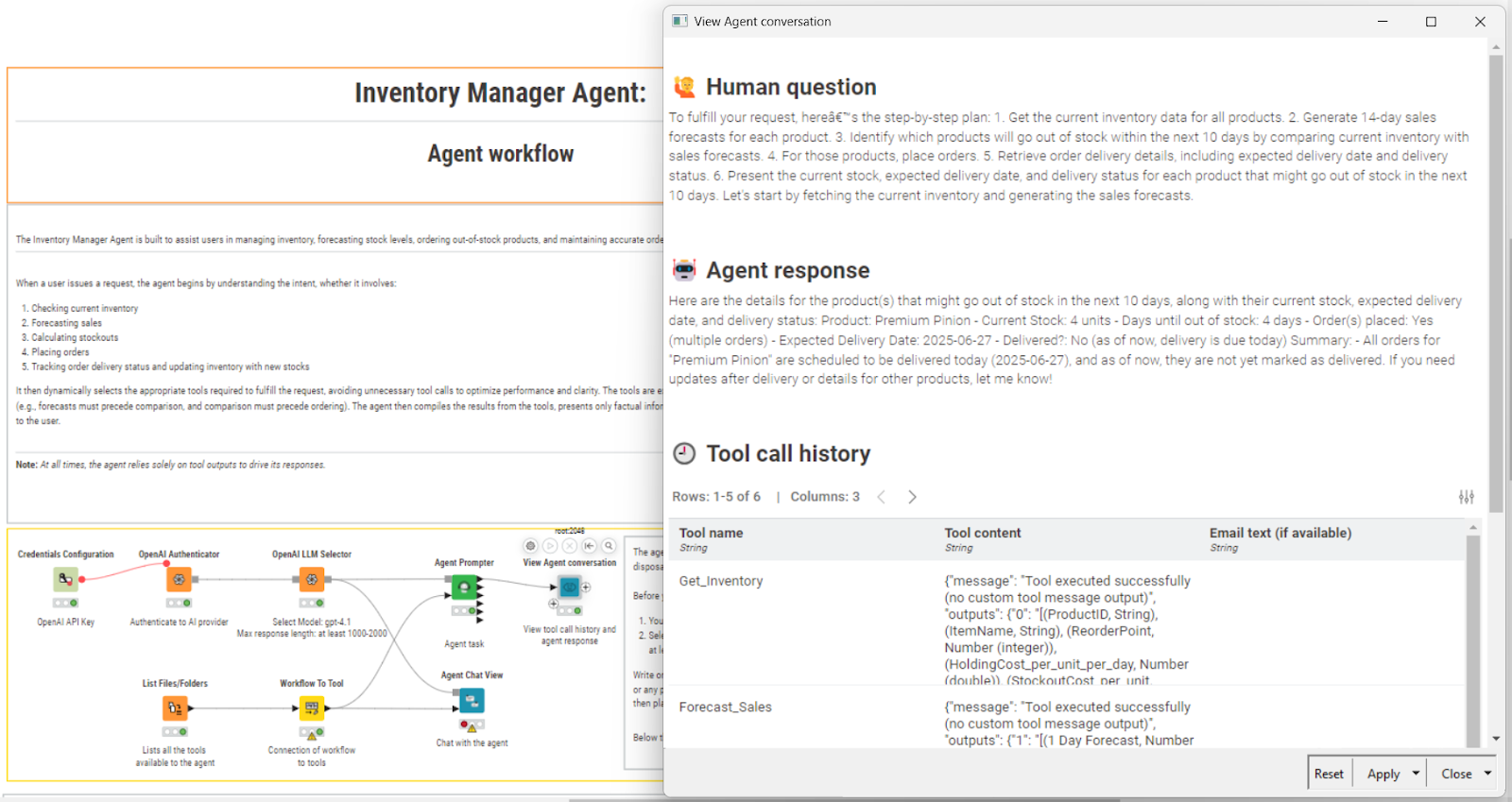
The Inventory Manager Agent supports inventory management by forecasting demand, reordering products, and tracking delivery status. It determines the sequence of actions, for example, forecasting before comparison and comparing before ordering, and avoids unnecessary steps to improve efficiency.
Retailers and warehouse managers often experience stockouts or excess inventory due to outdated forecasting. The agent reasons about dependencies and coordinates tools to support real-time, data-based decisions. This results in improved stock turnover, fewer missed sales, and optimized storage costs.
Unlike traditional automation, which follows fixed steps, the Inventory Manager Agent adapts to changing conditions. For example, if forecasts show no imminent stockouts, it skips comparisons or order placements. If the data is incomplete, it adjusts its reasoning instead of stopping. This goal-driven approach is suited to dynamic supply chains where conditions change frequently.
Where You Can Use It:
- Managing retail and e-commerce inventory
- Predicting seasonal or promotional sales surges
- Automating warehouse replenishments
- Optimizing vendor order cycles
2. Recovering overdue revenue with automated follow-ups
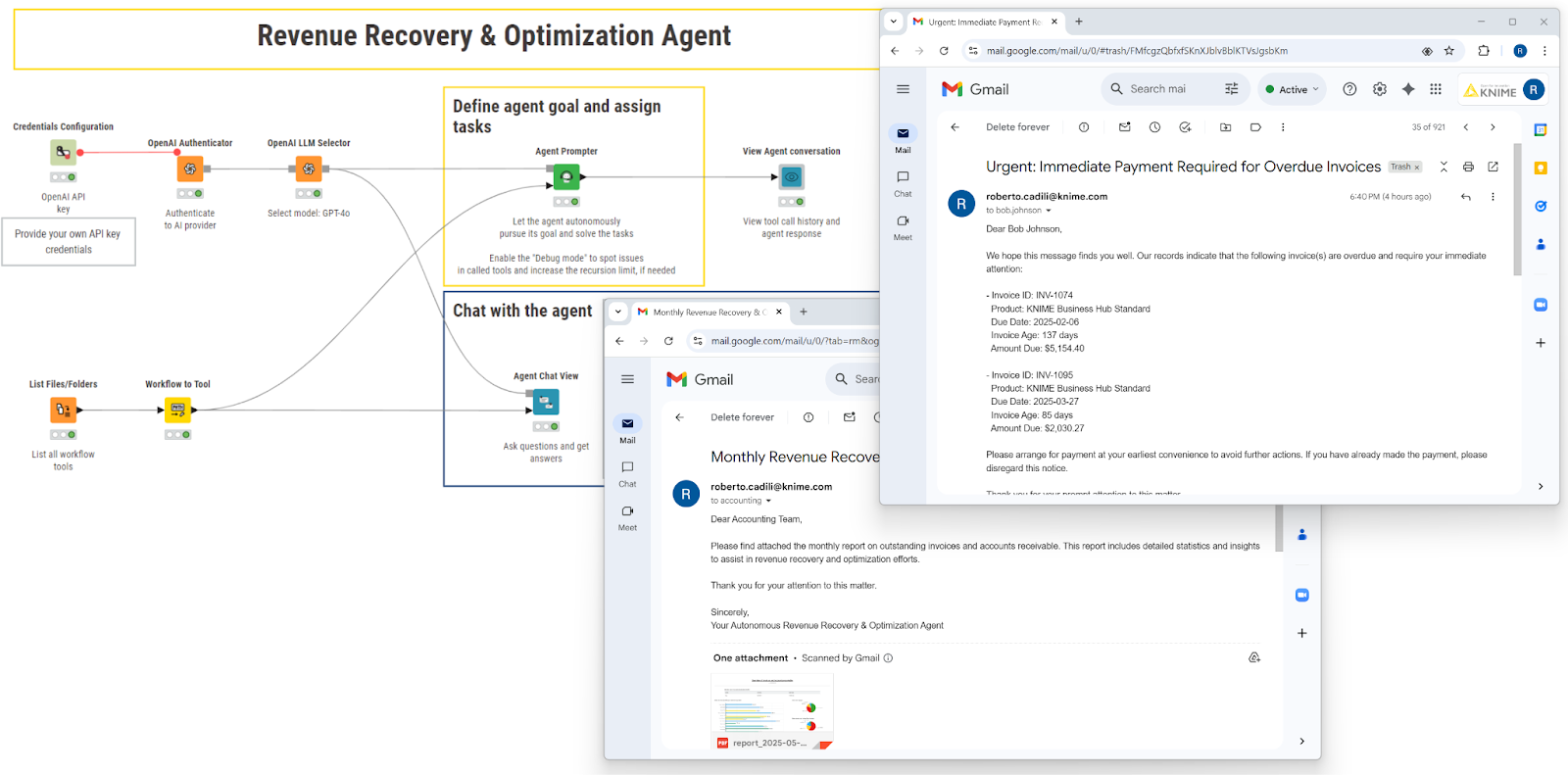
Late payments of customer invoices can strain operations and delay growth. The Revenue Recovery and Optimization Agent supports accounting teams by monitoring payments, sending tailored follow-up reminders, updating tracking sheets, and generating internal reports automatically.
Late payments are a bottleneck for cash flow, and manual follow-ups are time-consuming and prone to errors. This agent automates repetitive work and reasons about how to prioritize and group tasks, something static automation does not do. For example, instead of sending a generic reminder for each invoice, it groups multiple invoices for the same customer and adjusts the tone based on the delay severity.
Its agentic, goal-driven behavior distinguishes it from standard automation. Traditional automation executes all steps for every invoice, regardless of urgency or data quality. The Revenue Recovery and Optimization Agent dynamically decides what to do based on available data, skipping reporting if no overdue invoices exist, adjusting its approach if invoice data is incomplete, and selecting only the necessary steps to meet its primary goal: recovering revenue with manual effort.
Where You Can Use It
- Following up on overdue invoices for accounting and finance teams
- Automating accounts receivable tracking for small to mid-sized businesses
- Managing recurring subscription payments and dunning processes
- Generating periodic revenue recovery reports for financial oversight
3. Validating expense claims with automated policy checks
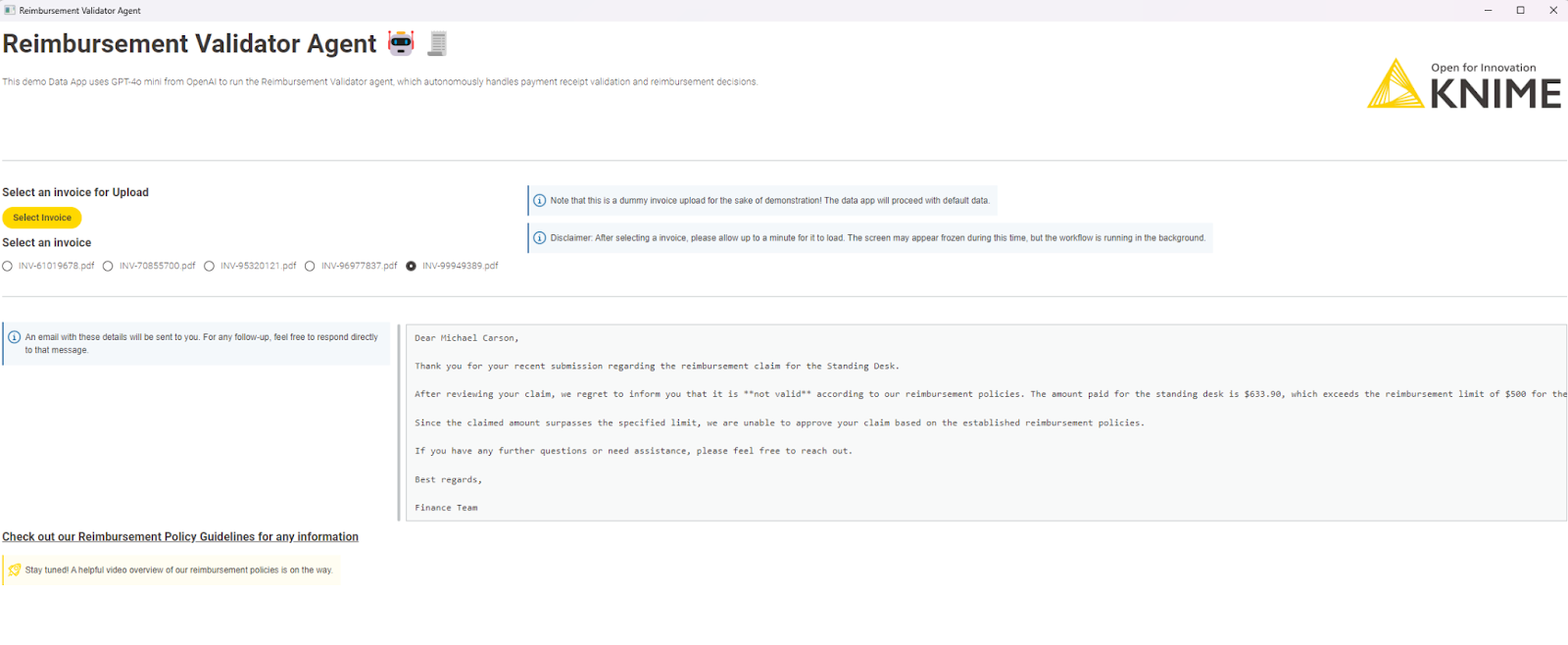
The Reimbursement Validator Agent automates the reimbursement process by validating receipts within financial workflows. Instead of manual data extraction and policy review, this agent monitors incoming invoices, extracts relevant details, checks policy compliance, and informs employees whether a reimbursement claim is valid.
It operates end-to-end using two specialized tools from its repository:
- Intelligent Parser Tool: Extracts key details such as vendor, service type, cost, and dates from PDFs or scanned receipts.
- Intelligent Policy Compliance Checker Tool: Compares the extracted details with company reimbursement policies and emails the user with the result, indicating whether the claim is approved or rejected.
Expense approvals often face delays and errors due to manual receipt checks and inconsistent policy application. Automating this workflow speeds up approvals and reduces manual errors.
Unlike traditional automation, this goal-driven agent adapts based on the type and completeness of the uploaded receipt. If some data is missing, it still processes the claim partially and provides a response instead of stopping.
It performs only the required steps, skipping parsing if structured data is already available. This adaptability supports financial workflows where invoice formats and policy rules often vary.
Where You Can Use It
- Validating employee travel and expense reimbursements
- Automating vendor invoice compliance checks
- Ensuring corporate policy adherence in accounts payable workflows
- Streamlining expense claim approvals for large organizations
4. Reducing churn with sentiment-driven personalization
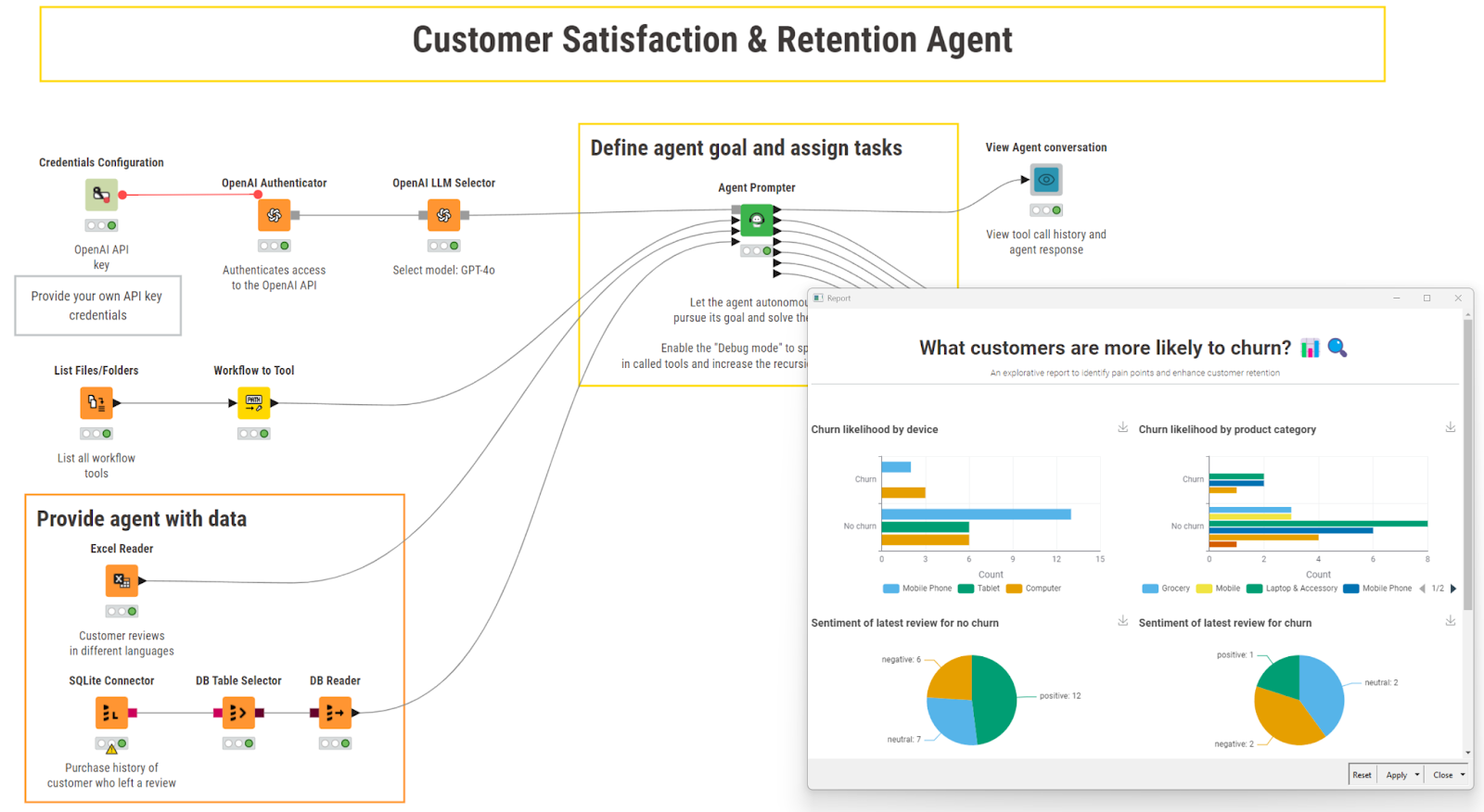
In competitive online retail, retaining customers starts with detecting dissatisfaction early and responding appropriately. The Customer Satisfaction and Retention Agent supports marketing and sales teams by monitoring customer sentiment, predicting churn risk, and delivering personalized outreach. It also compiles insights to improve the overall customer experience.
The agent operates end-to-end using multiple specialized tools:
- Sentiment Analysis & Language Detection: Classifies product reviews as positive, negative, or neutral and detects the language to ensure responses match the customer’s preferred language.
- Churn Prediction: Identifies high-risk customers using a machine learning classifier that analyzes review sentiment, purchase behavior, and demographics.
- Gift Selection & Email Personalization: For customers likely to leave, recommends a goodwill gift based on frequently co-purchased products and generates a personalized email with product highlights.
- Internal Reporting: Produces a PDF report with churn predictions, highlighting behavioral and sentiment patterns to guide retention strategies.
Customer churn directly impacts revenue, and traditional retention workflows often rely on manual monitoring or broad, generic campaigns. This agent automates the process of monitoring reviews, predicting churn, and creating personalized offers, enabling teams to focus on strategic tasks rather than manual follow-ups.
Its adaptability and context awareness distinguish it from static automation. The agent selects tools based on customer risk level and available data. For example, if churn risk is low, it skips gift selection; if demographic data is missing, it uses sentiment and purchase history to make predictions. This goal-driven reasoning mirrors how a human retention specialist prioritizes but operates at scale and with consistent accuracy.
Where You Can Use It
- Preventing churn in online retail and e-commerce businesses
- Automating customer support follow-ups based on review sentiment
- Running personalized win-back campaigns for subscription services
- Identifying product quality issues through aggregated sentiment and churn insights
5. Answering internal questions instantly with an agentic knowledge base
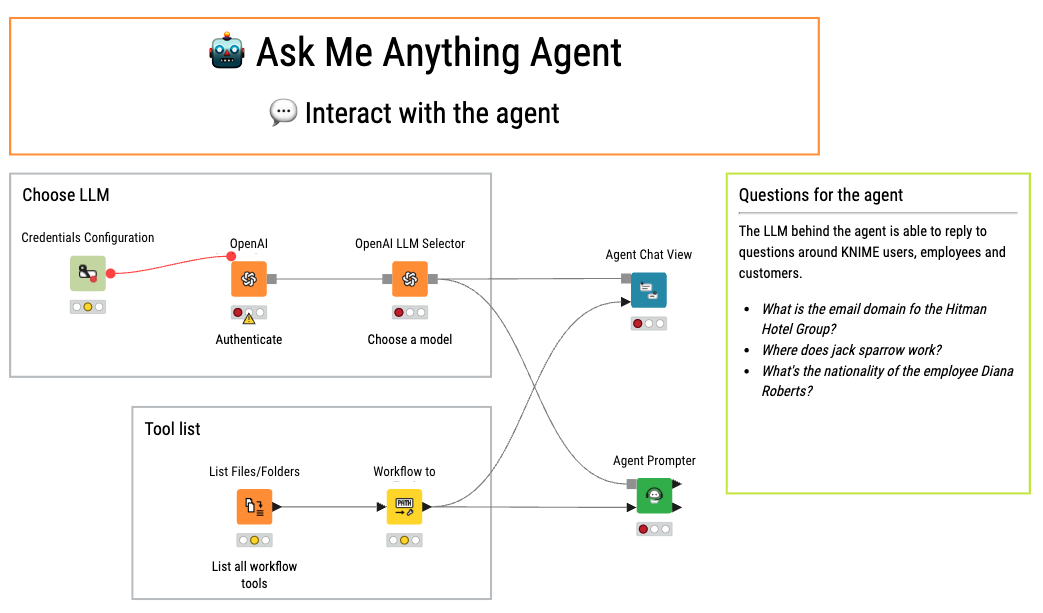
The Ask Me Anything (AMA) Agent functions as a centralized internal knowledge base where employees can ask questions in natural language through a chat interface. The agent interprets the query, identifies relevant tools and data sources, retrieves information, and provides a single consolidated answer, whether the question concerns employees, customers, or users.
Finding internal information is often slow and fragmented. Employees spend time navigating multiple dashboards, spreadsheets, or documents. The AMA Agent reduces this effort by serving as a single point of access to relevant data.
Its goal-driven approach distinguishes it from traditional search or FAQ bots. Instead of running fixed queries, the agent selects data sources and tools based on the question’s intent. For example, if someone asks, “Who is handling the ACME account, and what is the latest update?”, it retrieves data from employee directories and CRM systems and combines the results into a single response. If a source is unavailable, it still provides partial results instead of stopping.
Where You Can Use It
- Internal knowledge lookup for HR, Sales, or Support teams
- Quick access to customer and account details from multiple systems
- Reducing time spent switching between dashboards or documentation
- Acting as a conversational interface for company-wide data
From use cases to your own agentic workflows
The use cases above show how agentic AI in KNIME can automate complex, goal-oriented processes across different business areas. By combining reasoning with dynamic tool orchestration, these agents handle tasks such as inventory management, revenue recovery, and customer retention with greater efficiency and adaptability.
Building and adapting these workflows in KNIME today lays a solid foundation for creating more adaptive, intelligent systems that can evolve alongside changing business requirements.
